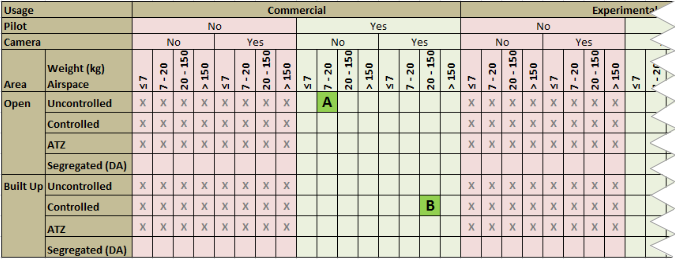For those of you that own a commercial Unmanned Aerial Vehicle (UAV), do you know the aviation rules that you need to abide by when flying it in the UK?
If the answer is no, then the UK Civil Aviation Authority’s (CAA’s) CAP 722 Unmanned Aircraft System Operations in UK Airspace – Guidance should house the answer*. However with the complex document extending to 110 pages long, in addition to the subtle rule changes depending on the use and UAV specifications, it can be difficult to be certain of the rules that apply.
What can change the rules that apply to my commercial UAV?
 The specific rules for a planned UAV operation depend on:
The specific rules for a planned UAV operation depend on:
- Weight
- Purpose of the flight
- Airspace classification e.g. controlled or uncontrolled
- Proximity to housing and people
- Intended flight profile.
In fact, we decided to produce a table to represent all the possible rule combinations for different UAVs based on the CAP 722 Guidelines. The table showed that there are over 396 different possible scenarios that have been identified each with its own particular set of requirements. We’ve showed part of the table below. The crosses indicate that this combination of requirements isn’t allowed.
Each segment of that grid represents a scenario governed by slightly varying sets of rules. We have chosen two segments – A & B – to represent a generalisation of the CAP 722 guidelines apply to operating a UAV fitting those specifications.

Real world example
| Example | 10kg UAV without Camera flying in Rural Environment | 30kg UAV with Camera flying in Urban Environment |
| Segment (See above) | A | B |
| Insurance | Required | |
| Pilot qualifications | None | Basic National UAS Certificate |
| Aircraft certification | Not Required | Required |
| Aircraft registration | Not Required | Required |
| Autonomous operation | Not Permitted | |
| Standard Operating Procedures | Required | |
| CAA clearance requirement | Required | Required |
| Local airport clearance requirement | Not Required | Require |
| Site Assessment | Required | |
| Maximum Flying Height | 400 feet | |
| UAV maximum distance from pilot | 500m | |
| UAV minimum distance from people | 50m | |
| UAV minimum distance from buildings and structures | 50m | 50m and 150m from congested areas |
Note the above data is very generalised. All operational situations require assessment on a case by case basis.
How We Can Help
Pager Power can advise on requirements for specific situations and undertake site assessments for specific UAVs and planned operations. Please get in touch if ou would like todiscuss a project. Call +44 (0) 1787 319001 or email info@pagerpower.com
* For model aircraft there is further procedures outlined in the CAP 658 document.
Image accreditation: “Flying drones at the Harris Flights” by John Mills via Flickr / CC BY 2.0
References
CAP 722 Unmanned Aircraft System Operations in UK Airspace – Guidance, UK Civil Aviation Authority (CAA), published in 2012. (Last Accessed 13/01/2015)
